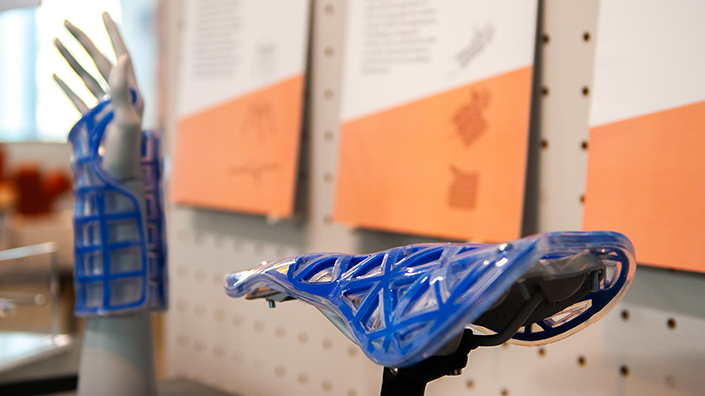In the future, turning a flat sheet of composite material into a 3D footrest or bedside table could be as simple as turning on a hairdryer and directing it towards the flatpack’s joints. The furniture would “rise off the floor,” says James Fraser, mechanical engineer at Re:flex.
Self-assembling furniture is just one part of the vision. Inspired by nature, the ambitious researchers and budding entrepreneurs hope to transform everything from medical casts, bike parts, surgical robots and deployable space structures. Components will be reusable, personalised, simple to use – flexible.
Natural resilience
“Natural materials and structures constantly respond and adapt to changes in the environment,” says Re:flex, which is backed by the Royal Commission for the Exhibition of 1851. “This makes organisms resilient to change.”
This natural resilience inspired Fraser and colleagues during a three-month group project on the Innovation Design Engineering programme, a two-year course run by Imperial College London and the Royal College of Art.
“We were really interested in natural organisms and processes, and how in a lot of these natural systems… the natural material is the machine,” says Fraser to Professional Engineering. “You don’t have – in the same way – components and sub-assemblies within something like a tree, for example. It all grows together but different parts of it function in different ways.”

James Fraser (second from right) with design engineer Karlijn Sibbel, electrical engineer Pierre Azalbert and designer Benton Ching
Plants also respond to external factors, such as a pine cone opening after humidity and temperature changes. The researchers wanted to “embody” that natural movement in the human-made world.
They turned to shape memory materials (SMMs). The materials deform after being heated, letting users shape them before they ‘freeze’ into that specific shape. They then remain in that shape until they are heated again to a certain temperature, when they deform and revert to their original shape.
The transformative possibilities of SMMs, which include shape memory polymers (SMPs) and shape memory alloys (SMAs), are clear. They also have some major drawbacks.
“They have been around for over 30 years, some of them, but they are still very expensive and very hard to get hold of,” says Fraser. “They are mostly in research labs across the world and there are only one or two-mass distributed materials. They are also very difficult to process and work with.” SMPs need particularly high temperatures and pressure during manufacturing, and SMAs require roughly 500ºC heat to reset.
Not satisfied with the available offering, the team set out to make its own SMM. After some research, it decided to create a shape memory hybrid (SMH), following work by Zhen Ding at Nanyang Technological University in Singapore. SMHs include two materials that do not demonstrate SMM properties, but combining them creates a composite that does. The team’s result was the material that gives their name – re:flex.
More… flexible
Conventional SMMs have been limited in application thanks to their prohibitive price – NASA has used them, and others have included small ‘wires’ in architectural facades. In contrast, re:flex is reportedly easy to manufacture and “much lower” cost, making it potentially applicable in a huge range of areas.
One of the first prototyped creations was a reusable cast for broken arms. “It would come flat and then you would heat it up and apply it to someone’s arm. Then you cool it down and it fits to that shape,” says Fraser. “After six weeks and the bone has set again you can lower their arm into a bath of warm water and the cast will unfold itself and you can clean it and use it for someone else.”
Although the technique has not yet been medically tested, the start-up believes it could hold numerous advantages. It is easily customisable, fitting to different people. Thanks to its reusability, it could help the NHS save significant amounts of money.

The prototype cast (left) and bicycle saddle
Other medical devices might benefit from the heat deformation and resetting aspect of re:flex. A one-size-fits-all orthotic could be moulded to patients’ feet, replacing custom-made insoles. At the other end of the spectrum, the team has spoken to a “leading” robotics researcher at Imperial who suggested the material could be useful on surgical robots because it acts as a single-component mechanism and can be moved and controlled from outside the body.
In furniture such as the self-assembling stool, re:flex material can work as a thermal actuator, where a change in shape of one material creates a larger movement throughout objects.
Beyond furniture and biomedical applications, Fraser flies through other potential uses – ergonomic computer accessories, adjustable bicycle saddles, deployable space structures, even dive computers moulded to swimmers’ wrists to make sure they stay put underwater. But while the team hopes to demonstrate the material in useful applications, it is also keen to hear ideas from other people on how to use the material in everyday life.
By making objects more flexible and reusable, Re:flex could make the world more sustainable. If it makes furniture assembly even simpler, it looks like a win-win.
Content published by Professional Engineering does not necessarily represent the views of the Institution of Mechanical Engineers.